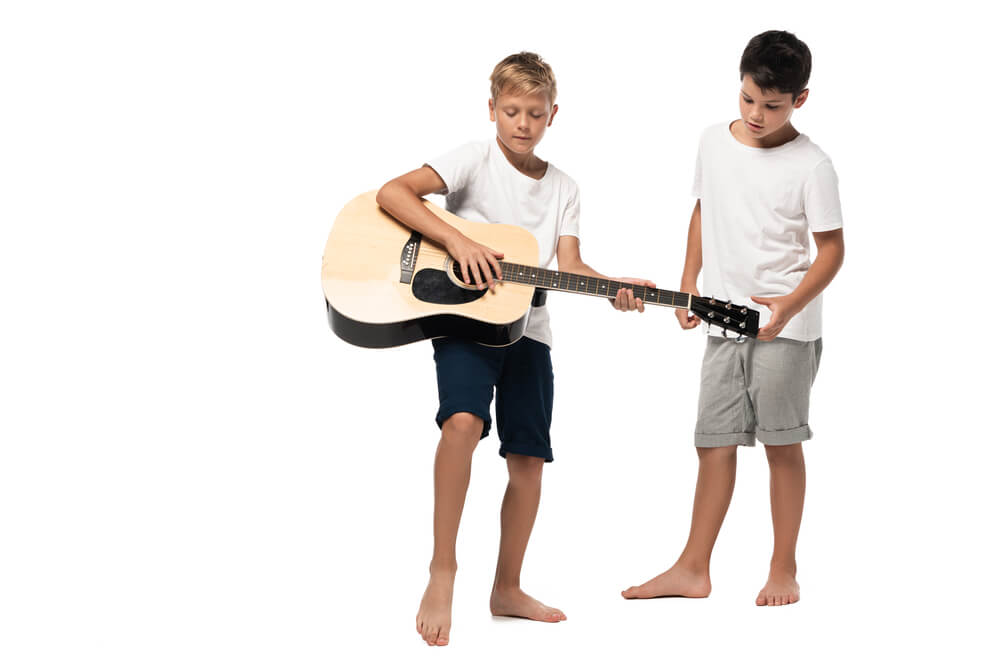When shopping for a kids’ guitar, you might be surprised by the wide range of prices. Some guitars can be quite expensive, leaving you wondering why they cost so much.
In this article, we’ll explore the factors that contribute to the high cost of some kids’ guitars and help you understand whether or not it’s worth the investment.
Guitars for children can be made from various materials and have different levels of craftsmanship and varying features. The expense may sometimes be justified by better quality or certain desirable characteristics that can enhance a young musician’s learning experience.
As you read on, you’ll gain insight into the major factors that drive the prices of kids’ guitars, so you can make an informed decision when selecting the perfect instrument for your child.
Key Takeaways
- Some kids’ guitars are expensive due to factors like materials, craftsmanship, and features
- The benefits of more expensive guitars may include better sound quality and improved playability
- Balancing your child’s needs and budget is essential when choosing the right guitar for them
Why Are Some Guitars So Expensive
The inception of Kids Guitars
The history of guitars goes back thousands of years, but the concept of guitars specifically designed for children is a more recent development.
As guitar playing became more popular and accessible, the demand for smaller instruments tailored for younger or smaller players began to rise.
Manufacturers realized the potential in this market and started producing kids’ guitars, which cater to youngsters’ needs with features like smaller bodies, shorter scale lengths, and simplified controls.
In order to understand what paved the way for kids’ guitars, it’s essential to recognize the roots of the instrument itself.
One of the oldest surviving guitar-like instruments dates back to Ancient Egypt, belonging to a singer named Har-Mose, who performed for Queen Hatshepsut.
This early instrument can be seen today at the Archaeological Museum in Cairo, Egypt.
Fast forward to more recent times, and the introduction of smaller guitars is often attributed to companies like Martin, Gibson, and Fender, which began producing shorter-scale instruments in the 20th century.
As the guitar evolved, so too did the needs and desires of the players, and manufacturers continued to design and innovate with those factors in mind.
The expense of some kid’s guitars can be attributed to various factors, such as material quality, build location, and luthier skill, among other elements.
Although there are budget-friendly options available, investing in a higher-priced kids’ guitar might provide better playability and sound quality, inspiring a lifelong passion for music in budding musicians.
As you navigate the world of kids’ guitars, remember that the perfect instrument for your child should strike a balance between affordability, sound quality, and playability.
Encourage their creativity and curiosity and help them discover the joy of playing guitar.
Types of Kids Guitars
When you’re searching for a guitar for your child, it’s essential to know the different types of kids’ guitars available. This will help you make an informed decision and find the perfect instrument for your young musician.
Acoustic Guitars: These are popular choices for beginners because they produce a natural and resonant sound without any need for amplification.
Acoustic guitars usually come in two subcategories: classical guitars with nylon strings and steel-string guitars. Classical guitars are great for kids because they have a softer feel, making it easier for small fingers to press down on the strings.
Steel-string guitars, on the other hand, produce a louder and brighter sound but can be more challenging to play for beginners due to the higher string tension. Some of the best acoustic models for kids include the Fender CC-60S and the Yamaha FG800.
Electric Guitars: These guitars require an amplifier to produce sound, making them more versatile in terms of tone and volume.
Electric guitars are generally easier to play because of their thinner necks and lighter strings, which can be beneficial for kids with smaller hands. One of the top electric guitars for children is the Epiphone Les Paul SL Starter Pack.
When choosing a kid’s guitar, keep in mind the size of the instrument. Manufacturers often offer 1/2 or 3/4 size guitars designed for younger players with shorter arms and smaller hands.
Examples of smaller-sized guitars include the Yamaha CGS102A Half-Size Classical Guitar and the Yamaha JR1 3/4 Size Acoustic Guitar.
Now that you know the types of kids’ guitars and some popular models, you’ll be well-equipped to choose the best instrument for your child.
Remember, the most important factor when selecting a guitar is that it’s comfortable for your child to play and helps them develop their skills while having fun.
Factors Driving High Prices
Materials and Craftsmanship
When it comes to the price of kids’ guitars, the materials used and the craftsmanship involved play crucial roles. High-quality materials such as tonewoods and rosewood contribute to a guitar’s overall sound and quality, raising its cost.
Additionally, meticulous craftsmanship and attention to detail ensure that the finished product meets high standards in terms of sound, playability, and durability.
Brand and Reputation
Another factor impacting the cost of kids’ guitars is the brand and reputation of the manufacturer. Well-known guitar makers have invested significant time and effort into building their reputations for producing high-quality instruments.
As a result, their guitars are often more expensive due to the prestige of owning a guitar from a respected brand.
Size and Complexity
While smaller in size compared to adult guitars, kids’ guitars still contain complex components. For example, electric guitars require pickups which are labor-intensive and expensive to produce.
Even though kids’ guitars are usually simpler in design, the time and effort required to manufacture the intricate pieces still drive up costs.
Location of Manufacture
Lastly, the location where a guitar is made also influences its price. Guitars crafted in regions with higher labor costs are generally more expensive.
Further, maintaining strict quality control measures during manufacturing and ensuring proper setup before shipping can add to the overall cost of producing a guitar.
Comparing Affordable and Expensive Kids Guitars
When you’re looking for a guitar for your child, you’ll likely come across a wide range of prices. But what’s the difference between an affordable kids’ guitar and a more expensive one?
In this section, we’ll dive into some key factors that contribute to these variations in cost.
Firstly, the materials used in the construction of the guitar play a significant role in determining the price.
Cheaper guitars often use less expensive wood and lower-quality components, while more expensive guitars tend to use premium woods like ebony or Brazilian rosewood, which can raise the overall price considerably.
Another factor to consider is the brand and reputation of the guitar manufacturer. Renowned companies like Gibson and Fender invest in research and development to ensure that their instruments offer exceptional sound, playability, and durability.
This added value can come with a higher price tag. On the other hand, lesser-known and budget-friendly brands like Squier often provide a more accessible option for beginners.
Build quality and craftsmanship also impact the price of kids’ guitars. Expensive instruments typically undergo a more rigorous production process, with particular attention paid to detail and quality control.
On the contrary, affordable guitars may have simpler designs, with less attention paid to finishes and overall construction, but they can still provide a satisfactory experience for a young beginner.
Lastly, consider the additional features that a kid’s guitar may offer, such as built-in electronics, alternative tunings, and unique designs. These added elements not only contribute to the instrument’s overall appeal but also to its price.
More expensive guitars tend to come with extra features that may cater to specific preferences or aid in learning.
So, when selecting a kid’s guitar, it’s essential to weigh these factors against your budget and the specific needs of your child.
You might find that an affordable option like the Squier Mini Strat is suitable for younger kids just starting out, while a pricier option might make sense for older children who are more serious about their musical journey.
Impact of Expensive Guitars on Learning
When considering an expensive guitar for your child, it’s crucial to understand the impact it may have on their learning and musical development.
A high-quality guitar can make a significant difference in your child’s playing experience.
Firstly, better materials often found in expensive guitars can lead to improved sound quality, durability, and playability. Guitars made of premium woods like Ebony or Brazilian Rosewood produce richer, more resonant sounds.
As a result, your child may be more motivated to practice and play if they enjoy the sound they are producing.
Furthermore, expensive guitars typically undergo rigorous quality control procedures, ensuring that the instrument is set up correctly and made using top-notch materials.
This means that your child is more likely to play a comfortable and smooth guitar, allowing them to focus on their technique and musicality.
Another factor to consider is the craftsmanship involved in manufacturing higher-end guitars. Expert luthiers with years of experience pay attention to the smallest details in order to produce a truly exceptional instrument.
This may result in improved intonation, better action, and, ultimately, a more enjoyable playing experience.
However, it’s essential to be mindful of your child’s current skill level and future commitment to learning the guitar.
While an expensive guitar could offer all these benefits, it’s vital to balance the cost with your child’s ongoing interest and potential return on investment.
If your child is a beginner, a more affordable yet good-quality guitar may suffice. As their skills progress, you can consider upgrading to a higher-end guitar when it’s time.
While expensive guitars have multiple benefits, it’s essential to assess your child’s needs, skill level, and commitment before investing in a high-end instrument.
Steps to Choose the Right Guitar for Your Child
Before purchasing a guitar for your child, it is essential to consider their age, size, and skill level. In this section, we will discuss some key factors to help you choose the right guitar for your child.
1. Consider the appropriate guitar size: There are various guitar sizes available, such as 1/4 size, 1/2 size, 3/4 size, and full size. Selecting the right size depends on your child’s age, height, and arm length. Generally, 1/2-size guitars are suitable for children aged 7-9, 3/4-size guitars for children aged 10-12, and full-size guitars for teenagers and older.
2. Look for quality construction and materials: A well-built guitar with quality materials will have a better sound and be more enjoyable for your child to play. While you can still find decent guitars at lower prices, avoid buying a guitar for less than $100 since these tend to have poor sound quality and durability.
3. Acoustic or electric? As a beginner, your child can learn on either an acoustic or electric guitar. Acoustic guitars may be easier to start with since they don’t require additional equipment like an amplifier. However, electric guitars might be more exciting for your child if they are interested in playing rock or pop music.
4. Take note of the guitar’s playability: Regardless of the size and type of guitar you choose, ensuring it is easy to play is critical. A well-adjusted guitar will make it easier for your child to learn and progress. Some websites like FirstGuitar offer inspections, proper adjustments, and setup to ensure the guitar’s playability.
Remember to always involve your child in the decision-making process and take their preferences into account. This will ensure they are more engaged and motivated to learn and practice with their new guitar.
Conclusion
The cost of some kids’ guitars may be higher due to various factors. It’s essential to consider the material quality and sourcing, build location, and luthier ability, as well as the pickups and electronics in the case of electric guitars.
Keep in mind that when investing in a quality guitar for your child, you’re not only paying for the materials but also for the craftsmanship and work put into creating the instrument.
While purchasing, a more expensive guitar might feel like a considerable investment, understand that it can provide a better overall experience for your child.
A higher-quality instrument will typically offer improved sound, playability, and durability compared to a cheaper alternative. This can lead to increased enjoyment in playing and growth as a musician.
With this information, you can now make a well-informed decision when selecting a kids’ guitar. Remember to consider your budget, your child’s needs and preferences, and the various factors that contribute to the price of the instrument.
This way, you’ll find the perfect guitar for your child that will not only serve them well musically but also provide a positive learning experience. Good luck in your search, and happy playing!
Frequently Asked Questions
What factors contribute to a guitar’s price?
There are several factors that can contribute to a guitar’s price, including the materials used, craftsmanship, brand reputation, and demand. High-quality materials such as premium wood and hardware can significantly increase the cost of a guitar. Additionally, the level of craftsmanship and attention to detail during the manufacturing process can also affect the price.
How do high-quality materials impact a guitar’s cost?
High-quality materials, such as premium woods for the body, neck, and fingerboard, as well as quality hardware, can significantly increase the cost of a guitar. For instance, premium woods like ebony or Brazilian rosewood are often used on more expensive guitars due to their superior tonal qualities and attractive appearance. These materials are also typically more expensive, which adds to the overall cost of the instrument.
How does brand reputation affect a guitar’s price?
Brand reputation can also impact the price of a guitar, as established brands with a history of producing high-quality instruments often command a higher price. Consumers are often willing to pay a premium for a brand they trust, and that is associated with quality and reliability. It’s important to note that a higher price doesn’t always guarantee a better guitar, so it’s essential to do your research and try out a variety of brands and models to find the best fit for your needs.
Do expensive guitars always provide a better sound?
Expensive guitars do not always guarantee better sound, but they often provide improved tonal quality, resonance, and sustain compared to their lower-priced counterparts. Higher-priced guitars are generally made with better materials and craftsmanship, which can result in better sound. However, the overall sound quality will still depend on the player’s skill, style, and personal preferences.
What is the difference between a cheap and an expensive guitar for a learner?
When it comes to learning the guitar, the primary difference between a cheaper instrument and a more expensive one often lies in their playability and build quality. More expensive guitars tend to be easier to play due to their superior craftsmanship, which can be particularly beneficial for beginners. Additionally, higher-priced guitars may offer better sound and higher quality materials, making them more enjoyable to play and encouraging the learner to practice more.
Should a beginner invest in an expensive guitar for learning?
While more expensive guitars can offer better playability, sound, and materials, it isn’t always necessary for a beginner to invest in a high-priced instrument. It’s crucial to find a guitar that feels comfortable and is enjoyable to play, regardless of its cost. A functional, affordable guitar can still provide a rewarding and fulfilling learning experience. As a beginner gains experience and develops their skill level, they may later choose to invest in a more expensive guitar better suited to their needs and preferences.








